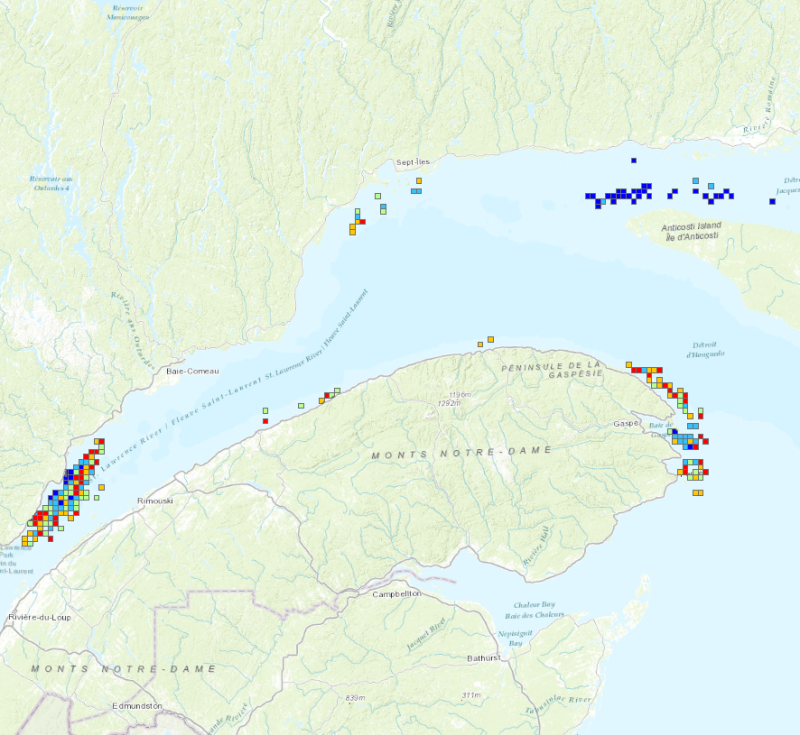Blue whale
Type of resources
Topics
Keywords
Provided by
Representation types
Update frequencies
status
-

A modelling analysis conducted by Fisheries and Oceans Canada (DFO) identified these areas as the most suitable habitat for Blue whales: Gulf of St. Lawrence, waters off the southern coast of Newfoundland, the region of Mecatina Trough, the Esquiman Channel and the continental shelf margin off Nova Scotia. They represent important areas for foraging, feeding and socializing for Blue whales. The sources of data used to determine these important areas (by the enclosing boxes method) and the annual and seasonal cycles of Blue whale travel patterns include, but are not limited to, radio and satellite telemetry, passive acoustic monitoring, line-transect aerial surveys, anecdotal reports of observations and modelling. This layer does not represent the general distribution of the Blue whale. Important areas have been identified by reviewing several sources of information and to the best of researchers' knowledge. Several information about Blue whales, their behaviour and habitat use are still unknown. Data is scarce in some areas during winter periods. Observation efforts mostly occur during the summer period, however, data sources can validate their presence during seasons when the observation effort is lower. The Mecatina trough region represents an important area based on historical and non-current data. The presence data per month refers strictly to the information available in the cited research document, and does not express the absence of the species outside the months when a presence was validated. The presented information is valid until the following research survey. Reference: Lesage, V., J.-F. Gosselin, J. W. Lawson, I. McQuinn, H. Moors-Murphy, S. Plourde, R. Sears. and Y. Simard. 2018. Habitats important to blue whales (Balaenoptera musculus) in the Western North Atlantic. DFO Can. Sci. Advis. Sec. Res. Doc. 2016/080: iv + 50 p.
-

Sightings data were collected by the Mingan Island Cetacean Study (MICS) from 1980 to 2008 with annual surveys realised in the Gulf of St. Lawrence between the end of may and early november. Surveys were conducted using inflatable boats enabling the close approaches necessary to photograph and biopsy blue whales. The aim of this project was to provide additional information for designating blue whale critical habitat as required under the Canadian Species at Risk Act. For more details consult the following report: Ramp, C. and Sears, R. 2013. Distribution, densities, and annual occurrence of individual blue whales (Balaenoptera musculus) in the Gulf of St. Lawrence, Canada from 1980-2008. DFO Can. Sci. Advis. Sec. Res. Doc. 2012/157. vii + 37 p. http://www.dfo-mpo.gc.ca/csas-sccs/Publications/ResDocs-DocRech/2012/2012_157-eng.html Data of blue whale sightings, collected by the MICS, have been analysed per km of effort in 3 x 3 km grid cells in the Gulf of St. Lawrence for the 2000-2008 period.
 Arctic SDI catalogue
Arctic SDI catalogue